Travel with Terri
Experiencing Antarctica: What It’s Really Like at the Bottom of the Earth
Story and Photos by Terri Marshall
Antarctica is one of those bucket list destinations that many dream about and few visit. I had to go because penguins make me happy. I could watch them for hours as they clumsily wander about all dressed up in permanent tuxedos. And seeing them in their natural habitat amid a landscape of snowcapped peaks and stunning icebergs is an experience I will treasure forever.
But it’s not just the penguins that make Antarctica special. The White Continent is home to albatross, whales, seals and numerous species of birds. It’s remote, fascinating, and almost otherworldly. But what is it really like to visit Antarctica? If you’re considering a trip, here are some things you should know.
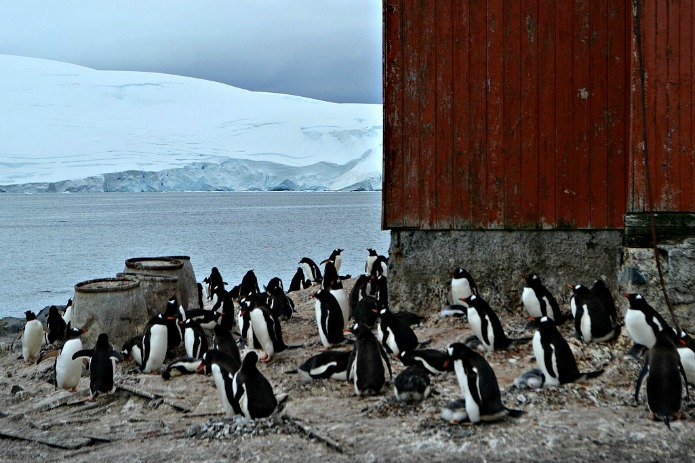
It’s a long journey to the bottom of the earth
If you’re traveling from the US, you will most like depart from South America. We arrived in Buenos Aires a few days before our scheduled departure, just to be sure we didn’t run into any travel delays that might interfere with our Antarctica adventure. From there, we boarded a charter flight to Ushuaia – the southernmost town in the world and the point of departure for most Antarctica expeditions.
Departing from Ushuaia, we sailed out through the Beagle Channel where the waters of the South Atlantic and the Pacific Oceans meet. The channel is a natural boundary between the neighboring countries of Argentina and Chile. From the channel we headed into the dreaded Drake Passage.
Separating South America from Antarctica, the waters of the Drake Passage are known to be the roughest in the world. In severe weather, waves can reach a height of over 33 feet. We were fairly lucky with a passing that ranked about a 5 on a scale of 10 as to difficulty. Others aren’t so lucky. The key to managing it is to have an array of sea sickness combatants on hand just in case.
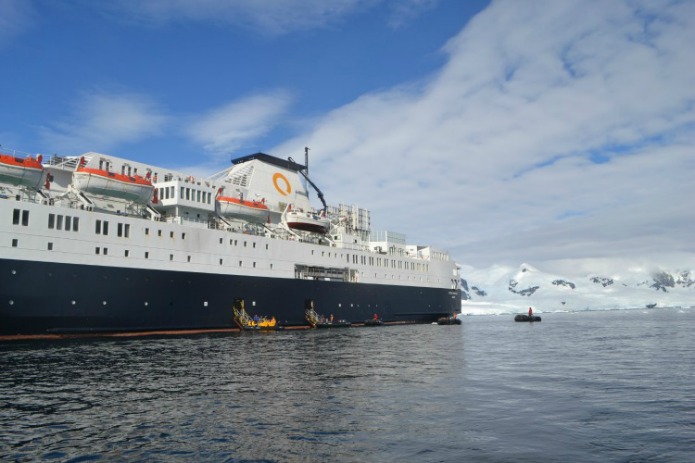
Size Matters – And bigger isn’t better
There are numerous companies offering cruises to Antarctica, but if you want to actually set foot on the continent, you will want to choose an expedition over a cruise. A small to mid-sized ice strengthened vessel is your best bet and companies like National Geographic, Hurtigruten, and Quark Expeditions are all good options.
For our expedition, we chose Quark. Our ship had about 180 passengers on board along with a fabulous expedition team comprised of environmentalists, historians, scientists, and photographers. We even had Penguin Lifelines Scientists from Oxford on board – isn’t that an awesome title?
The ship is your home base during the expedition. Quark’s M/V Ocean Endeavour offered comfortable accommodations, delicious meals, afternoon tea, wine tastings, numerous lectures, fitness center, a full service spa, and entertainment. And with a ship of less than 200 passengers, you really get to know your shipmates.
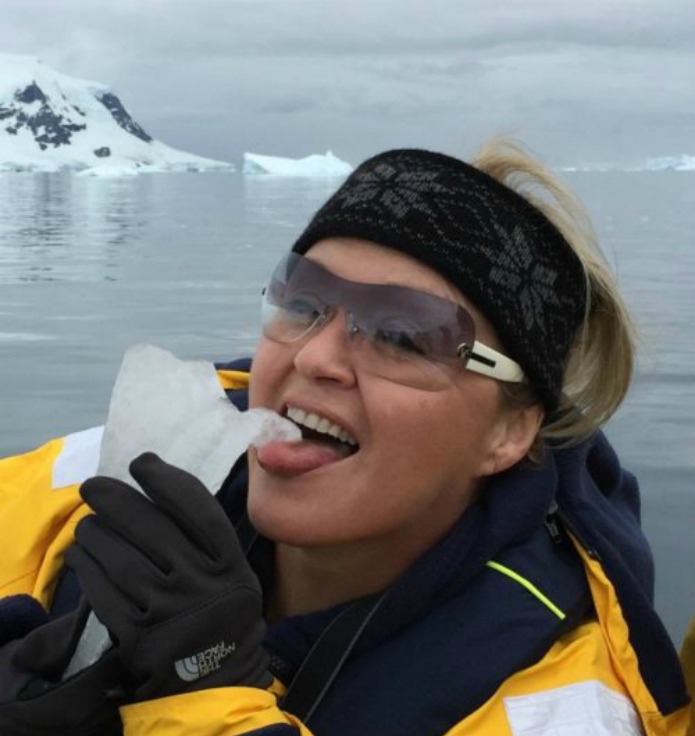
Everything is subject to change
No amount of planning can guarantee which experiences will be available for your expedition. Everything is subject to change based on weather, ice, whatever the seas want to whip up, and the wildlife you discover along the way. But that is truly part of the adventure.
The captain and expedition leaders are constantly observing the surrounding conditions to determine which way to go and which landings will be safe for exploration. Once anchored in a harbor, the landings are scouted out by expedition leaders before anyone is allowed to step foot onto the continent. If an area is deemed unsafe, you move on to another harbor. And there are plenty to choose from – it’s a big continent!
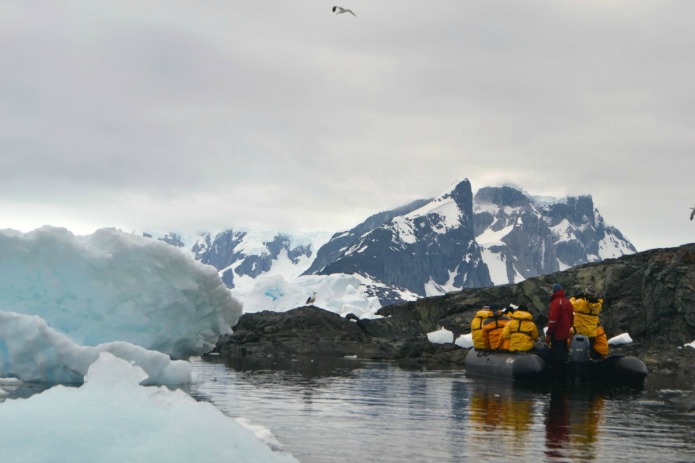
Exploring the Frozen Continent
Generally, an expedition will provide opportunities for everyone to land on the continent. Our ship was divided into four groups – Albatross, Leopard, Minke and Gentoo. Each day we’d wait for our group (the Gentoos) to be called to disembark. Then we would head down to the mudroom, don our bright yellow Quark Expedition parkas, life jackets and Muck boots then board the Zodiac cruisers.
Explorations included an hour or so on the continent and an hour of Zodiac cruising. We were greeted with blue skies, sunshine and temperatures around 35 degrees Fahrenheit as we took our first steps on the continent. We hiked around the land and watched the penguins traveling up and down the “penguin highways” from their nests to the water. We arrived just after the baby penguin chicks were hatched and watching the parents feeding and protecting their young was wondrous.
Aboard the zodiacs we cruised through iceberg galleries, watched seals lounging on the snow and ice, and scouted for whales which occasionally delighted us with an appearance. At times we just sat silently taking in the grandeur of all that surrounded us.
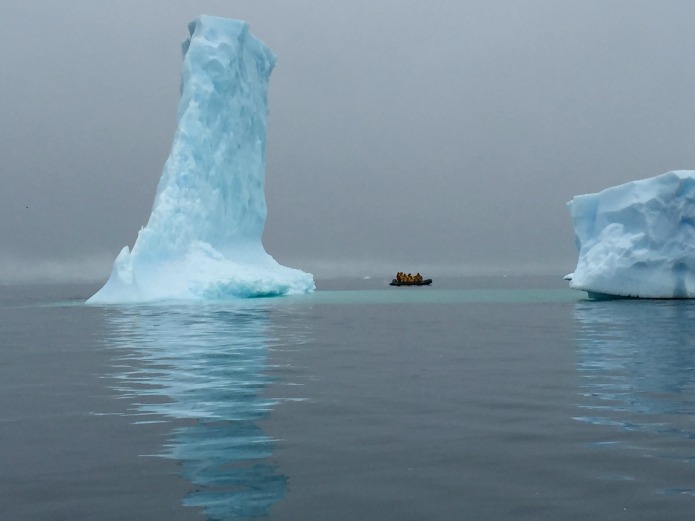
Want more icy experiences? Try camping or the Polar Plunge
Quark Expeditions offers the option to camp on the continent. I thought about it – but then I thought about the warm bed in my cabin, the bathroom just steps away, and the wine in the ship’s bar. While I’m sure it was a memorable experience, the reality of sleeping on ice all night with no bathroom facilities and no way back to the ship was met with mixed reviews by participants.
Scott, a teacher from Syracuse, New York, had a panic attack from the three layered cocoon style sleeping bag and seriously considered injuring himself so that he could be rescued and taken back to the ship. Mike, a consultant from Houston, Texas, was able to get a little sleep in between appreciating the serenity of the night sky and the eerie sounds of the glaciers shifting around them. Of course neither of them wants to do it again. But, hey, they did it.
The Polar Plunge is an entire other level of insanity where people jump off the ship from the Zodiac bridge into the icy waters of the Antarctic Ocean. Obviously they aren’t in the water long – but our expedition had over 40 frosty participants.
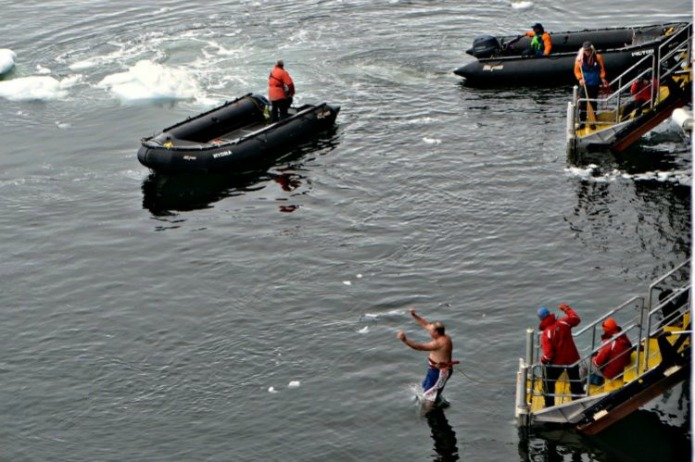
Every trip is unique
No matter who you talk to that has visited Antarctica – you will get a different story. Landings are determined based on weather, timing of your visit and conditions on land when you arrive. We visited in January after all the fuzzy little baby penguins had arrived. Someone visiting earlier or later in the season will have another wonder to experience.
On day two in Antarctica we were on track to pass through the Lemaire Channel into Pleneau Bay. The Lemaire Channel is a narrow passage that separates Booth Island from the Antarctic continent. At its narrowest, the channel is less than 800 meters wide with towering peaks overhead – and it is generally full of icebergs and sea ice. Our ship was going to attempt to break through the ice and, if successful, we would be the first to accomplish this in the season.
As the captain nudged the sheet of ice, it began to crack in several directions. Seals who had spent the last months lounging on the ice sheets began to roll into the water to move out of the ship’s path. Penguins waddled away from the cracks and hopped one by one into a single file line forming a true march of the penguins moment.
No one else will ever experience that. It was a moment – like so many other moments in Antarctica – that cannot be repeated. But don’t worry, if you go to Antarctica, you will experience something equally remarkable.
Terri is a New York City based writer who is happiest when she’s globetrotting. She loves bringing stories of her adventures to her readers. She is the Globetrotting Grandmom for TravelingMom.com, Special Projects Editor for TravelSquire.com, and a contributor to several other publications. You can learn more about Terri and her work at www.trippingwithterri.com. Connect with Terri on Facebook and follow her on Twitter

